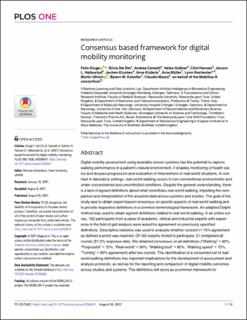| dc.contributor.author | Kluge, Felix | |
| dc.contributor.author | Del Din, Silvia | |
| dc.contributor.author | Cereatti, Andrea | |
| dc.contributor.author | Gassner, Heiko | |
| dc.contributor.author | Hansen, Clint | |
| dc.contributor.author | Helbostad, Jorunn L. | |
| dc.contributor.author | Klucken, Jochen | |
| dc.contributor.author | Küderle, Arne | |
| dc.contributor.author | Müller, Arne | |
| dc.contributor.author | Rochester, Lynn | |
| dc.contributor.author | Ullrich, Martin | |
| dc.contributor.author | Eskofier, Bjoern M. | |
| dc.contributor.author | Mazzà, Claudia | |
| dc.date.accessioned | 2023-02-16T17:15:14Z | |
| dc.date.available | 2023-02-16T17:15:14Z | |
| dc.date.created | 2022-01-11T11:28:23Z | |
| dc.date.issued | 2021 | |
| dc.identifier.citation | PLOS ONE. 2021, 16 (8), 1-14. | en_US |
| dc.identifier.issn | 1932-6203 | |
| dc.identifier.uri | https://hdl.handle.net/11250/3051724 | |
| dc.description.abstract | Digital mobility assessment using wearable sensor systems has the potential to capture walking performance in a patient’s natural environment. It enables monitoring of health status and disease progression and evaluation of interventions in real-world situations. In contrast to laboratory settings, real-world walking occurs in non-conventional environments and under unconstrained and uncontrolled conditions. Despite the general understanding, there is a lack of agreed definitions about what constitutes real-world walking, impeding the comparison and interpretation of the acquired data across systems and studies. The goal of this study was to obtain expert-based consensus on specific aspects of real-world walking and to provide respective definitions in a common terminological framework. An adapted Delphi method was used to obtain agreed definitions related to real-world walking. In an online survey, 162 participants from a panel of academic, clinical and industrial experts with experience in the field of gait analysis were asked for agreement on previously specified definitions. Descriptive statistics was used to evaluate whether consent (> 75% agreement as defined a priori) was reached. Of 162 experts invited to participate, 51 completed all rounds (31.5% response rate). We obtained consensus on all definitions (“Walking” > 90%, “Purposeful” > 75%, “Real-world” > 90%, “Walking bout” > 80%, “Walking speed” > 75%, “Turning” > 90% agreement) after two rounds. The identification of a consented set of real-world walking definitions has important implications for the development of assessment and analysis protocols, as well as for the reporting and comparison of digital mobility outcomes across studies and systems. The definitions will serve as a common framework for implementing digital and mobile technologies for gait assessment and are an important link for the transition from supervised to unsupervised gait assessment. | en_US |
| dc.language.iso | eng | en_US |
| dc.publisher | PLOS, Public Library of Science | en_US |
| dc.rights | Navngivelse 4.0 Internasjonal | * |
| dc.rights.uri | http://creativecommons.org/licenses/by/4.0/deed.no | * |
| dc.title | Consensus based framework for digital mobility monitoring | en_US |
| dc.title.alternative | Consensus based framework for digital mobility monitoring | en_US |
| dc.type | Peer reviewed | en_US |
| dc.type | Journal article | en_US |
| dc.description.version | publishedVersion | en_US |
| dc.source.pagenumber | 1-14 | en_US |
| dc.source.volume | 16 | en_US |
| dc.source.journal | PLOS ONE | en_US |
| dc.source.issue | 8 | en_US |
| dc.identifier.doi | 10.1371/journal.pone.0256541 | |
| dc.identifier.cristin | 1978150 | |
| cristin.ispublished | true | |
| cristin.fulltext | original | |
| cristin.qualitycode | 1 | |

